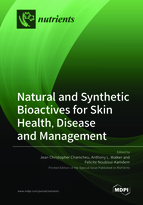Natural and Synthetic Bioactives for Skin Health, Disease and Management
A special issue of Nutrients (ISSN 2072-6643). This special issue belongs to the section "Phytochemicals and Human Health".
Deadline for manuscript submissions: closed (15 September 2021) | Viewed by 117414
Special Issue Editors
Interests: skin health and diseases; carcinogenesis; inflammation; dermatology; psoriasis; atopic dermatitis; bioactive natural products; antioxidants; polyphenols; flavonoids; tissue engineering; signaling pathways; pharmacology
Special Issues, Collections and Topics in MDPI journals
Interests: pharmacy practice; laboratory pedagogy and teaching styles; pharmaceutical compounding; natural products and formulation; compounding novel dosage forms for drug delivery; pharmacy practice clinical; educational and natural product research; health screening in under-privileged communities
Special Issues, Collections and Topics in MDPI journals
Interests: molecular mechanisms of cancer development and metastasis; role of IGF2BP1 in the pathology of colorectal cancer and basal cell carcinoma; cancer cell fusion and breast tumor heterogeneity and metastasis; mRNA turnover and cancer development
Special Issues, Collections and Topics in MDPI journals
Special Issue Information
Dear Colleagues,
Being the largest organ of the human body, the skin serves several functions, including being a physical and immunologic barrier ensuring normal human wellbeing. Biologically active natural/plant-derived product preparations and synthetic scaffolds are garnering interest as valid human health-promoting, disease prevention, and management entities, both in the modern and alternative medicine arenas. Several of these bioactives regulate vital physiological processes, including gene expression, protein synthesis, metabolism, differentiation, and growth by mechanisms that are not well understood. Through epidemiological and intervention studies, several of these bioactives have been claimed and/or proven to offer skin protection against aging, environmental hazards, oxidative stress, infection and several chronic inflammatory diseases like acne, atopic dermatitis, psoriasis, diabetic ulcers, chronic wounds, various skin cancers, and several associated risk factors. Moreover, cutting-edge research utilizing physiologically attainable doses in appropriate in vitro and preclinical model systems has provided some mechanistic insights. Additionally, validating the beneficial effects in terms of skin health of nutraceuticals or pharmaceuticals and acquiring a detailed understanding of their intake, pharmacokinetic/pharmacodynamics, dose–response relationship, and efficacy are warranted.
The purpose of this Special Issue is to update knowledge vis-à-vis the role of bioactive natural dietary and synthetic compounds on healthy and diseased skin, including the breast, and to shed light on the global relevance of scientific research findings on their usages. This may range from skin health promotion and cosmetic tanning, disease prevention and treatment, to reduction of adverse side effects, misuse, and purposeless spending.
To help bridge the current knowledge gap, this Special Issue of Nutrients invites the submission of manuscripts describing original research, short communication, legislative documentations or quality reviews of scientific literature in skin health promotion and disease prevention and treatment. These conditions may include but not be limited to infection, environment/oxidative stress, chronic inflammatory skin diseases like acne, atopic dermatitis, psoriasis, diabetic wounds, and various kinds of skin and breast cancers. Submissions addressing a broad range of topics are welcome, including studies covering bioavailability, understanding physiological functional processes, molecular targets, pathways and mechanisms of action from in vitro, preclinical animal models, human population, and dietary intervention studies to impacts on skin health, disease prevention and management, and advice on intake/usage and their outcomes are welcome.
We look forward to your exciting submissions.
Assist. Prof. Dr. Jean Christopher Chamcheu
Assoc. Prof. Dr. Anthony L. Walker
Assist. Prof. Dr. Felicite Noubissi-Kamdem
Guest Editors
Manuscript Submission Information
Manuscripts should be submitted online at www.mdpi.com by registering and logging in to this website. Once you are registered, click here to go to the submission form. Manuscripts can be submitted until the deadline. All submissions that pass pre-check are peer-reviewed. Accepted papers will be published continuously in the journal (as soon as accepted) and will be listed together on the special issue website. Research articles, review articles as well as short communications are invited. For planned papers, a title and short abstract (about 100 words) can be sent to the Editorial Office for announcement on this website.
Submitted manuscripts should not have been published previously, nor be under consideration for publication elsewhere (except conference proceedings papers). All manuscripts are thoroughly refereed through a single-blind peer-review process. A guide for authors and other relevant information for submission of manuscripts is available on the Instructions for Authors page. Nutrients is an international peer-reviewed open access semimonthly journal published by MDPI.
Please visit the Instructions for Authors page before submitting a manuscript. The Article Processing Charge (APC) for publication in this open access journal is 2900 CHF (Swiss Francs). Submitted papers should be well formatted and use good English. Authors may use MDPI's English editing service prior to publication or during author revisions.
Keywords
- Acne, atopic dermatitis, and psoriasis
- Antioxidants and phenolic compounds
- Breast cancer
- Bioavailability and bioactivity
- Environmental factors and skin health
- Skin beauty and biology
- Skin aging and disease
- Skin infection, immunity, and inflammation
- Skin cancer
- Skin care and wounds
- Natural dietary bioactives and Food supplement
- Nutraceuticals and synthetic bioactive products
- Natural dietary products as alternative medicine
- Natural/synthetic bioactive agents for chemoprevention
- Nanoformulations and nanomedicine
- Human intervention trials
- Natural products, preclinical and clinical trials in skin health
- Natural/synthetic Antimicrobials and immune-modulatory agents
- Phytonutrients for human skin health and disease








